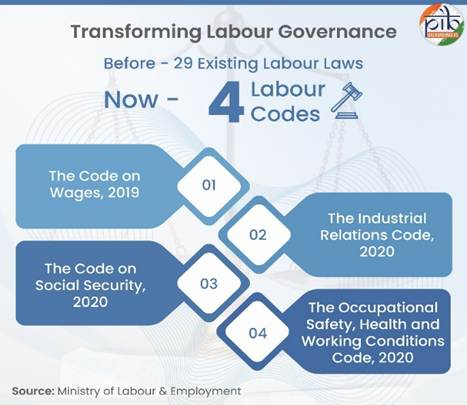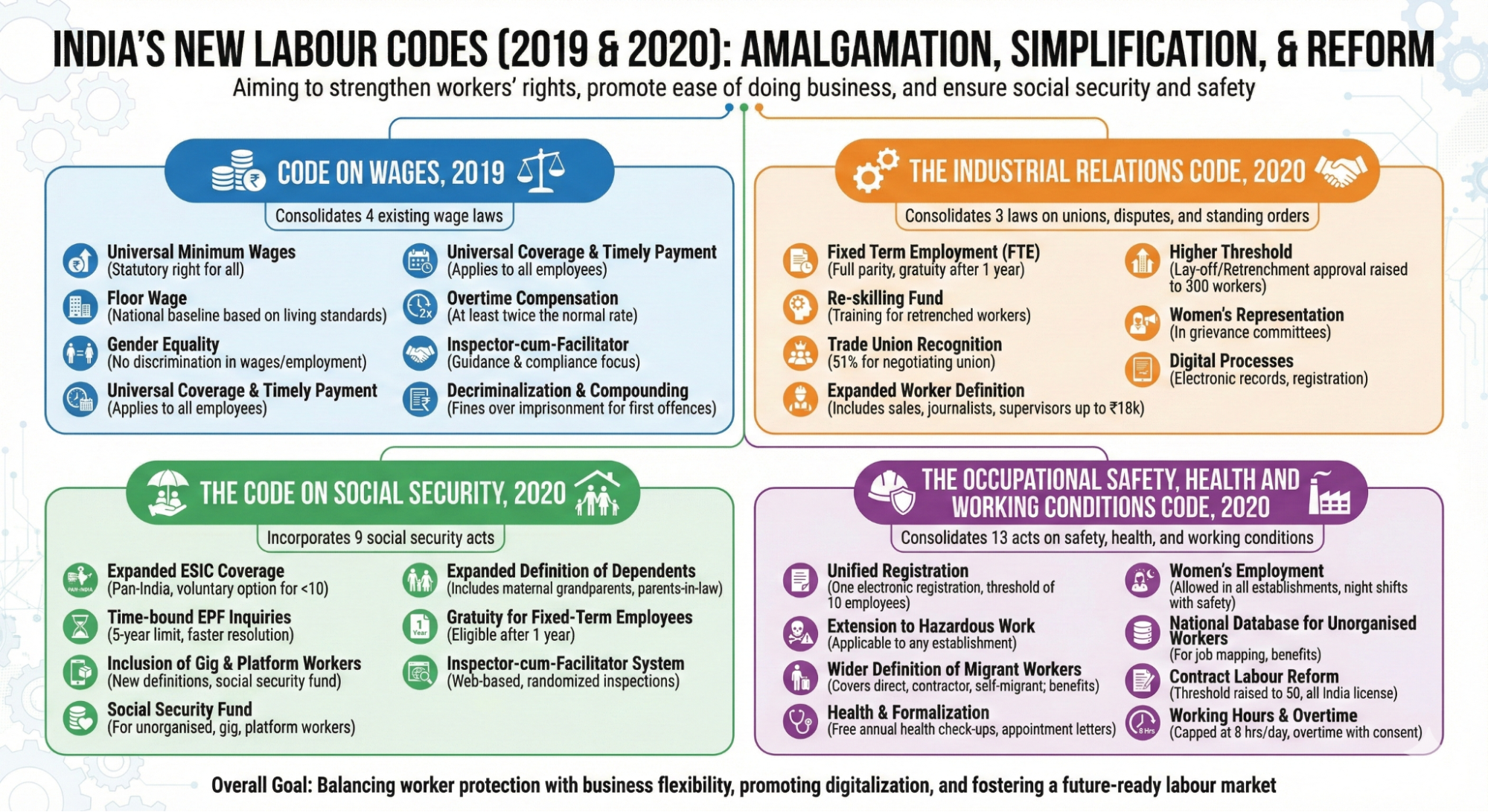Indian Economy
Nationwide Implementation of India’s Four Labour Codes
- 25 Nov 2025
- 15 min read
For Prelims: Code on Wages, 2019, Industrial Relations Code, 2020, Code on Social Security, 2020, Occupational Safety, Health and Working Conditions (OSH) Code, 2020,
For Mains: India’s Labour Codes: opportunities and challenges, Labour reforms and their role in employment generation and formalisation
Why in News?
India has announced the implementation of the four Labour Codes (the Code on Wages, 2019, Industrial Relations Code, 2020, Code on Social Security, 2020, Occupational Safety, Health and Working Conditions (OSH) Code, 2020) replacing 29 earlier labour laws.
- The reform aims to modernise labour regulation, strengthen worker protections and create a simpler, future-ready framework supporting a resilient workforce and Aatmanirbhar Bharat.
- The four labour codes were enacted based on the 2nd National Commission on Labour (2002), which recommended merging multiple labour laws into four functional codes.
What are the Key Provisions of the Four Labour Codes?
- Labour Code: A labour code is a consolidated set of laws regulating employer–employee relations, including wages, social security, industrial relations, and workplace safety.
India’s Four Labour Codes
- The Code of Wages, 2019: It merges four key laws (The Payment of Wages Act, 1936; The Minimum Wages Act, 1948; The Payment of Bonus Act, 1965; and The Equal Remuneration Act, 1976) into a single framework.
- It brings uniformity in wage rules, ensures fair and timely payment, promotes gender equality and simplifies compliance for employers while strengthening workers’ rights.
- The Industrial Relations Code, 2020: It combines and simplifies provisions from earlier laws like the Trade Unions Act, 1926, the Industrial Employment (Standing Orders) Act, 1946 and the Industrial Disputes Act, 1947.
- It seeks to balance worker rights with industrial stability by streamlining rules on union recognition, employment terms and dispute resolution.
- The Code on Social Security, 2020: It merges nine existing laws like The Employee's Compensation Act, 1923, The Employees' State Insurance Act, 1948, The Employees' Provident Funds and Miscellaneous Provisions Act, 1952 into one unified framework and extends benefits to all workers, including those in the unorganised, gig and platform sectors.
- It covers maternity, health, life insurance and provident fund benefits while promoting digital processes and easier compliance.
- The Occupational Safety, Health and Working Conditions Code 2020: It consolidates 13 labour laws such as Factories Act, 1948, Plantations Labour Act, 1951, and Mines Act, 1952.
- The Code aims to ensure safer working conditions while simplifying compliance for businesses, creating a more efficient, fair and future-ready labour framework.
|
Labour Code |
Major Provisions |
|
The Code of Wages, 2019 |
|
|
The Industrial Relations Code, 2020 |
|
|
The Code on Social Security, 2020 |
|
|
The Occupational Safety, Health and Working Conditions Code 2020 |
|
What is the Need to Reform India’s Labour Laws?
- Fragmented Legal Framework: India had 29 separate labour laws with overlapping provisions, making compliance complex and time-consuming for workers and employers.
- Outdated Provisions: Many laws were created during the pre-Independence and early post-Independence era, and no longer suited modern industry practices, technology, or new forms of employment.
- High Compliance Burden: Multiple licences, registrations and returns increased paperwork and made it difficult for businesses especially for Micro, Small, and Medium Enterprises (MSME) to operate smoothly.
- Limited Worker Coverage: Several protections applied only to specific categories or sectors, leaving large numbers of informal and unorganised workers uncovered.
- Changing Nature of Work: The rise of gig work, platform jobs, fixed-term employment and flexible service-based roles required updated regulatory frameworks.
- Global Competitiveness: Most major economies like Singapore have modernised and consolidated labour rules, and India needed similar reforms to attract investment and support growth.
- Improving Worker Welfare: The earlier system lacked uniform standards for wages, safety and social security, leading to gaps in labour protection.
- Boosting Employment and Formalisation: Simplified rules support industries, improve job creation and help shift workers from informal to formal employment.
What are the Key Concerns Regarding India’s New Labour Codes?
- Higher Compliance Burden for Small Businesses and MSMEs: Expanded ESIC, PF and safety mandates raise labour costs significantly for micro and small enterprises.
- MSMEs may need to restructure workforce size, invest in digital HR systems, medical checks and new workplace standards.
- Coordination Between Centre and States: Labour falls under the Concurrent List, so both the Centre and states must frame and align their rules.
- State-level flexibility in thresholds and exemptions may create confusion, compliance gaps and legal disputes, resulting in uneven worker protections across the country.
- Regulating Strikes and Union Recognition: The 51% single-union rule may marginalise smaller unions and complicate representation.
- Strike restrictions may escalate tensions rather than prevent them if workers feel procedural hurdles are unfair.
- Awareness Gap Among Workers: Many workers especially informal, migrant and contractual may not understand new entitlements such as appointment letters, ESIC, floor wages or grievance rights.
- Concerns Around Fixed-Term Employment: Employers may overuse FTE contracts to avoid permanency, increasing job insecurity.
- Courts may face rising litigation on whether repeated fixed contracts constitute disguised permanent employment.
- The retrenchment approval threshold has increased from 100 to 300 workers, offering employers more flexibility but potentially weakening worker protection.
- Workforce Disruption During Transition: Changes in wage structures, overtime rules, and employment categorisation may lead employers to pause hiring.
Constitution and Labour Legislation in India
- Role of the Preamble: The Preamble outlines values such as justice, liberty, equality, and dignity, which form the moral foundation for labour laws.
- Though not enforceable, it guides the interpretation of labour legislation in favour of workers.
- Labour laws reflect principles like social justice, economic fairness, and protection of vulnerable workers.
- Fundamental Rights and Labour Laws (Part III: Articles 14–35):
|
Right |
Relevant Articles |
Labour Link |
|
Equality |
14–18 |
Fair wages, non-discrimination based on caste, gender or status |
|
Freedom |
19–22 |
Freedom of association ( trade unions) |
|
Against Exploitation |
23–24 |
Prohibits forced labour, child labour in hazardous work |
|
Life and Personal Liberty |
21 |
Right to dignified work conditions |
|
Constitutional Remedies |
32–35 |
Public interest Litigation (PIL) used for labour rights enforcement |
- Key Judgments:
- Bandhua Mukti Morcha (1984): Right to live with dignity includes labour rights.
- People’s Union for Democratic Rights (1983): Less than minimum wage amounts to forced labour under Article 23.
- Neerja Choudhary (1984): Bonded labour must be rehabilitated.
What Measures are Needed for Effective Implementation of the New Labour Codes?
- Uniformity Across States: To harmonize implementation of Labour codes, a model rulebook or intergovernmental labour council could reduce confusion and ensure uniform protection standards nationwide.
- Safeguards Against Misuse of Fixed-Term Employment: Clear guidelines must prevent employers from using fixed-term contracts to avoid permanency.
- Regular audits and grievance redressal mechanisms should protect workers from disguised exploitation.
- Strengthen Social Security for Gig Workers: Develop a National Gig and Platform Workers Policy mandating aggregator contributions.
- Capacity and Compliance Support for MSMEs: Provide digital helpdesks, simplified filing modules, and temporary fiscal support (such as EPF co-payment) to help small firms absorb cost and compliance transitions.
Conclusion
The new Labour Codes mark a major shift in India’s labour framework, aiming to balance worker welfare with business efficiency. By simplifying compliance, improving safety and ensuring fair wages, the reforms set the foundation for a more transparent, equitable and growth-oriented labour ecosystem that supports both workers and industry.
|
Drishti Mains Question: Q. India’s consolidated Labour Codes strike a balance between labour welfare and industrial flexibility.” Critically examine. |
Frequently Asked Questions (FAQs)
1.Which body originally recommended consolidation of labour laws?
The Second National Commission on Labour recommended grouping existing labour laws into broad functional codes.
2.What is the Rationale Behind Codification of Existing Labour Laws?
To simplify complex and outdated labour laws into a modern, uniform framework that improves compliance, worker protection and ease of doing business.
3.Do the Labour Codes provide a universal minimum wage?
Yes. The Code on Wages ensures a universal minimum wage for all workers and introduces a floor wage that states cannot set wages below.
4.How are gig and platform workers covered under the reforms?
Gig and platform workers receive statutory recognition under the Social Security Code, with aggregators required to contribute 1–2% of annual turnover (capped at 5% of payouts) towards a welfare fund.
UPSC Civil Services Examination, Previous Year Questions (PYQs)
Prelims
Q. In India, which one of the following compiles information on industrial disputes, closures, retrenchments and lay-offs in factories employing workers?
(a) Central Statistics Office
(b) Department for Promotion of Industry and Internal Trade
(c) Labour Bureau
(d) National Technical Manpower Information System
Ans: (c)
Mains
Q. Discuss the merits and demerits of the four ‘Labour Codes’ in the context of labour market reforms in India. What has been the progress so far in this regard? (2024)






